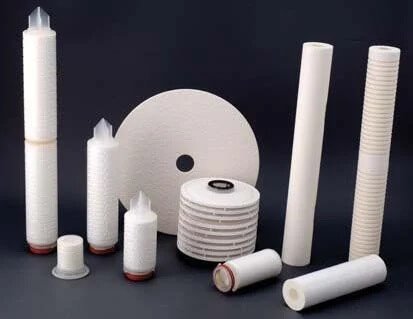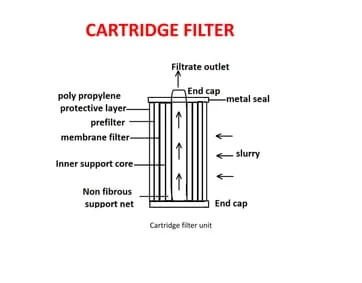What is a Cartridge Filter
A cartridge filter is a type of filter that employs a porous cartridge as the medium for trapping impurities from liquids or gases. It is usually made of materials like paper, polyester, or other synthetic fibers, and its design allows for efficient filtration by trapping particles of varying sizes. Cartridge filters are employed in a wide array of industries due to their adaptability and effectiveness.
Design and Construction of Cartridge Filter
Cartridge filters are designed with precision to achieve optimal filtration results. The basic structure consists of a cylindrical or pleated cartridge encased in a housing. The filter material is carefully chosen based on the specific requirements of the application.
The filtration process involves the liquid or gas passing through the porous surface of the cartridge. The impurities get trapped within the filter media, allowing only the clean substance to pass through. The design can vary, with some featuring a single cartridge, while others may incorporate multiple cartridges in a parallel or series configuration.
Applications of Cartridge Filters
Water Treatment:
Cartridge filters are extensively used in water treatment systems for residential, commercial, and industrial purposes.
They effectively remove sediment, chlorine, bacteria, and other contaminants from water, ensuring it meets quality standards.
Industrial Processes:
In manufacturing and industrial settings, cartridge filters play a crucial role in maintaining the purity of liquids used in processes such as chemical production and food and beverage manufacturing.
Pharmaceuticals:
The pharmaceutical industry relies on cartridge filters to achieve the high levels of purity required for drug manufacturing.
Automotive:
Cartridge filters are commonly used in automotive engines to filter oil and ensure that the engine runs smoothly by preventing contaminants from damaging internal components.
HVAC Systems:
Heating, ventilation, and air conditioning (HVAC) systems use cartridge filters to capture dust, pollen, and other airborne particles, improving indoor air quality.
Benefits of Cartridge Filters
High Efficiency:
Cartridge filters offer high filtration efficiency, effectively removing particles of various sizes from the fluid or gas.
Easy Maintenance:
Maintenance of cartridge filters is relatively straightforward. Depending on the design, cartridges can be easily replaced or cleaned, minimizing downtime.
Versatility:
Cartridge filters can be customized for specific applications, making them versatile and suitable for a wide range of industries.
Cost-Effective:
In many cases, cartridge filters are more cost-effective than other filtration methods, offering a balance between performance and affordability.
Cartridge filters ensure the purity of liquids and gases in various industries. Their versatility, efficiency, and ease of maintenance make them a popular choice for applications ranging from water treatment to industrial processes. The cartridge filters continue evolving, meeting the ever-growing demands for cleaner and purer fluids and gases in our daily lives.
SOP for cleaning of cartridge filter
Objective: To lay down a procedure for cleaning the cartridge filter.
Scope: This SOP is applicable for cleaning the cartridge filter.
Responsibility: Production Officers / Executive.
Accountability: The production Head shall be accountable for the compliance of SOP.
Abbreviations
SOP: Standard Operating Procedure.
WFI : Water for Injection
IPA : Isopropyl alcohol
LAF : Laminar Air Flow
Cough Relief tablet
Procedure
Close the valves and remove the filter housing from the line.
Put a blind at the opening using a tri-clover clamp.
Transfer the filters to Wash Equipment Area and carry out the cleaning operation under the LAF unit.
Take out the filters from housing and clean surface of housing with lint free duster.
Clean the filters and housing by washing thoroughly with water for injection or Iso Propyl Alcohol (IPA) respectively for Hydrophilic and Hydrophobic filters.
Dip the filters in 10 liters of water for Injection or Iso Propyl Alcohol in Stainless Steel vessel respectively for Hydrophilic and Hydrophobic filters for around 5 minutes with gentle shaking in between.
Take out the filters after 5 minutes and gently shake to remove excess Water for Injection or Iso Propyl Alcohol from the filters.
Dry the filters using compressed air at a pressure not exceeding 0.5 Kg/cm2.
Assemble the filters in their respective housings and fix back to their respective lines.
Write the date of cleaning and due date for cleaning on the Filter Status Tag.
Enter cleaning details in the Filter Cleaning Record Annexure-1
Frequency: Filter Cleaning require after 15 days and Filter Replacement require 6 month or whenever filter integrity is fails.
List of Cartridge Filter
Washing and sterilization Room
Hydrophilic Filter
Vial Washing Purified water line (Pore Size – 5.0m)
Vial Washing Water for Injection line (Pore Size – 1.0m)
Hydrophobic Filter
Vial Washing Compressed air line (Pore Size – 0.22 m)
Garment washing Room
Hydrophilic Filter
Garment washing Purified water line (Pore Size – 1.0m)
Garment Washing water for Injection (Pore Size – 1.0m)
Hydrophobic Filter
Garment Washing Compressed air line (Pore Size – 0.22m)
Wash Equipment Area
Hydrophilic Filter
Purified water line (Pore Size – 1.0m)
Water for Injection (Pore Size – 1.0m)
Hydrophobic Filter
Compressed air line (Pore Size – 0.22m)
Bung Processor cum Autoclave
Hydrophilic Filter
Purified water line (Pore Size – 1.0m)
Water for Injection (Pore Size – 1.0m)
Hydrophobic Filter
Compressed air line (Pore Size – 0.22m)
Cooling Zone
Hydrophobic Filter
Compressed air line (Pore Size – 0.22m)
Vacuum Break filter of autoclave (Pore Size – 0.22m)
Vial Filling Room
Hydrophobic Filter
Compressed air line (Pore Size – 0.22m)
Nitrogen Line (Pore Size – 0.22m)
Vacuum Line (Pore Size – 0.22m)
Forms and Records:
Cleaning of Cartridge Filter Record
Filter Replacement Record
Annexure-1
Cleaning of Filter Record
Filter Location/Filter ID No./Filter Type/Pore Size:
| Date | Cleaned By | Checked By | Next Due date |
Annexure – 2
Filter Replacement Record
Description of filter/Filter Location/Filter ID No./Pore size
| Date | Previous Filter | New Filter | Checked By | ||
| Lot. No. | Part No. | Lot. No. | Part No. | ||



